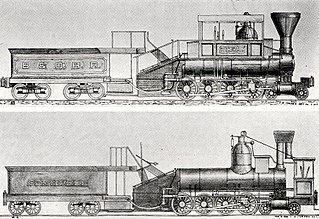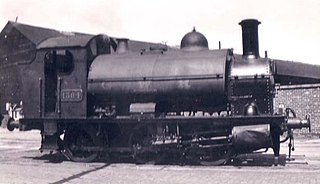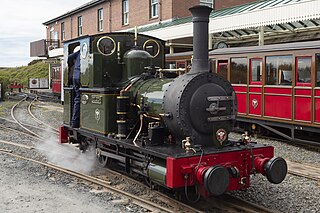
A tank locomotive is a steam locomotive which carries its water in one or more on-board water tanks, instead of a more traditional tender. Most tank engines also have bunkers to hold fuel; in a tender-tank locomotive a tender holds some or all of the fuel, and may hold some water also.

Under the Whyte notation for the classification of steam locomotives, 4-8-2 represents the wheel arrangement of four leading wheels, eight powered and coupled driving wheels and two trailing wheels. This type of steam locomotive is commonly known as the Mountain type, though the New York Central Railroad used the name Mohawk for their 4-8-2s.

Under the Whyte notation for the classification of steam locomotives, 4-8-0 represents the wheel arrangement of four leading wheels on two axles, usually in a leading truck or bogie, eight powered and coupled driving wheels on four axles and no trailing wheels. In North America and in some other countries the type was usually known as the Twelve-wheeler.

The United States Army Transportation Corps (USATC) S100 Class is a 0-6-0 steam locomotive that was designed for switching (shunting) duties in Europe and North Africa during World War II. After the war, they were used on railways in Austria, China, Egypt, France, Great Britain, Greece, Iran, Iraq, Israel, Italy, the Netherlands, Palestine, the United States, and Yugoslavia.

The 1361 Class were small 0-6-0ST steam locomotives built by the Great Western Railway at their Swindon Works, England, mainly for shunting in docks and other sidings where track curvature was too tight for large locomotives.

The NZR B class of 1899 was a class of steam locomotives that operated on New Zealand's national rail network. An earlier B class of Double Fairlies had entered service in 1874, but as they had departed from the ownership of the New Zealand Railways (NZR) by the end of 1896, the B classification was free to be re-used. Despite early difficulties, they were amongst NZR's most influential designs.
During the 1880s and 1890s, William Dean constructed a series of experimental locomotives to test various new ideas in locomotive construction for the Great Western Railway.

Under the Whyte notation for the classification of steam locomotives by wheel arrangement, 2-6-2+2-6-2 is an articulated locomotive using a pair of 2-6-2 power units back to back, with the boiler and cab suspended between them. The 2-6-2 wheel arrangement has a single pair of leading wheels in a leading truck, followed by three coupled pairs of driving wheels and a pair of trailing wheels in a trailing truck.

Under the Whyte notation for the classification of steam locomotives by wheel arrangement, a 2-8-2+2-8-2 is an articulated locomotive using a pair of 2-8-2 power units back to back, with the boiler and cab suspended between them. The 2-8-2 wheel arrangement has a single pair of leading wheels in a leading truck, followed by four coupled pairs of driving wheels and a pair of trailing wheels in a trailing truck. Since the 2-8-2 type was known as Mikado, the corresponding Garratt and Modified Fairlie types were usually known as Double Mikado.

Dolgoch is a narrow gauge 0-4-0 well tank steam locomotive. It was built by Fletcher, Jennings & Co. and is one of the oldest locomotives still in active service. It was delivered to the Talyllyn Railway in 1866 and continues to run on this railway to this day.

London and North Western Railway (LNWR) 2-2-2 No. 3020 Cornwall is a preserved steam locomotive. She was built as a 4-2-2 at Crewe Works in 1847, but was extensively rebuilt and converted into her current form in 1858.

A launch-type, gunboat or horizontal multitubular boiler is a form of small steam boiler. It consists of a cylindrical horizontal shell with a cylindrical furnace and fire-tubes within this.

The South African Railways Class 15B 4-8-2 of 1918 was a steam locomotive.

The South African Railways Class 14C 4-8-2 of 1922 was a steam locomotive.

The South African Railways Class 12B 4-8-2 of 1920 was a steam locomotive.

The South African Railways Class 6Z 2-6-4 of 1901 was a steam locomotive from the pre-Union era in the Cape of Good Hope.

The South African Railways Class FC 2-6-2+2-6-2 of 1925 was an articulated steam locomotive.
The South African Railways Class GE 2-8-2+2-8-2 of 1925 was an articulated steam locomotive.

The South African Railways Class GO 4-8-2+2-8-4 of 1954 was an articulated steam locomotive.

A steam motor is a form of steam engine used for light locomotives and light self-propelled motor cars used on railways. The origins of steam motor cars for railways go back to at least the 1850s, if not earlier, as experimental economizations for railways or railroads with marginal budgets. These first examples, at least in North America, appear to have been fitted with light reciprocating engines, and either direct or geared drives, or geared-endless chain drives. Most incorporated a passenger carrying coach attached to the engine and its boiler. Boiler types varied in these earlier examples, with vertical boilers dominant in the first decade and then with very small diameter horizontal boilers. Other examples of steam motor cars incorporated an express-baggage or luggage type car body, with coupling apparatus provided to allow the steam motor car to draw a light passenger coach.




















